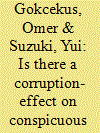|
|
|
Sort Order |
|
|
|
Items / Page
|
|
|
|
|
|
|
| Srl | Item |
| 1 |
ID:
175317


|
|
|
|
|
| Summary/Abstract |
n the last decades, Brazil has become a regional military and economic power in South America, accounting in 2017 for the largest defence budget in the region, the eleventh defence expenditure in the world, and almost 60% of South American GDP. The enactment of the National Defence Policy resulted in an increase in defence expenditure in Brazil that was primarily focused on developing and buying modern equipment and paying better salaries. The policy was implemented during three investment cycles that began with off-the-shelf acquisitions and moved to the execution of defence programmes aiming to develop indigenous technologies, substituting imports on the way. Despite the effort, we argue that the most likely scenario is that the achievement of the vision established in the National Defence Policy will be compromised, and that constant delays caused by the expenditure constraints might result in the delivery of outdated technologies and weapon systems, keeping a never-ending technological gap.
|
|
|
|
|
|
|
|
|
|
|
|
|
|
|
|
| 2 |
ID:
090111


|
|
|
|
|
| Publication |
2009.
|
| Summary/Abstract |
In the published literature, the differences in environmental performance across countries are typically explained using the Environmental Kuznets Curve. The Environmental Kuznets Curve states that pollution initially increases with economic growth. Once GDP per capita reaches a certain level, the relationship reverses. In the present paper, we provide an alternative hypothesis, where budget structure plays an important role in explaining the variations in pollution across the world: the lower the business-related taxes as a share of total tax revenue, the higher the property tax in total tax revenue and the higher the ratio of public health expenditure in total expenditure, then the stronger the incentive of pollution control and the lower the pollution level. Our empirical findings reveal that the budget structure does have an important impact on pollution control. The policy implication of this research is that effective control of environmental pollution requires changes in tax structure and expenditure assignment. This research has important policy implications for China's tax system reform and pollution control efforts.
|
|
|
|
|
|
|
|
|
|
|
|
|
|
|
|
| 3 |
ID:
105795


|
|
|
|
|
| Publication |
2011.
|
| Summary/Abstract |
An explorative survey was carried out on rural and semi-urban households to find out the energy consumption pattern with respect to socio-demographic and geographic factors in Bangladesh by using stratified random sampling technique. The study revealed that 100% of the households used biomass, 98% kerosene, 61% electricity, 23% LPG and 5% candle in the rural areas. In the semi-urban areas, 100% of the households used electricity, candle and natural gas, 60% kerosene and 13% petrol. Households' mean expenditure for total energy was US$ 5.34 (SE, 0.43) with total income US$ 209.84 (SE, 6.69) month-1 in the rural areas, while it was US$ 6.20 (SE, 1.35) in the semi-urban areas with the total income US$ 427.76 (SE, 24.19) month-1. This study may be a useful baseline information to energy policy makers in Bangladesh.
|
|
|
|
|
|
|
|
|
|
|
|
|
|
|
|
| 4 |
ID:
133881


|
|
|
|
|
| Publication |
2014.
|
| Summary/Abstract |
This study empirically explores the following issue: Does corruption fuel conspicuous consumption? It examines the existence and magnitude of any potential corruption-effect on conspicuous consumption expenditure. Regression analyses of an unbalanced panel data for 20 OECD countries between 2004 and 2010 indicate that luxury car sales are higher by 191 per cent in a country with a high perceived corruption level, for example, CPI score of 4.5, as compared to a country with a low perceived corruption level, for example, CPI score of 9.0, ceteris paribus.
|
|
|
|
|
|
|
|
|
|
|
|
|
|
|
|
| 5 |
ID:
109781


|
|
|
| 6 |
ID:
132518


|
|
|
|
|
| Publication |
2014.
|
| Summary/Abstract |
This article investigates the role of the final expenditure components in determining Nepal's imports from India using the Autoregressive Distributed Lag approach based on the annual data for the period 1975-2011. The results of bounds testing procedure show that there exists the cointegration between Nepal's imports from India and its determinants: personal consumption expenditure, government consumption expenditure, investment, exports and relative prices. Among the expenditure components, personal consumption expenditure is a major determinant of import demand from India, with its significant positive impact. The government expenditure is found to have no significant impact on Nepal's imports from India. Gross domestic investment and exports have negative impact on Nepal's import demand from India, whereas the relative prices have positive impact, indicating lack of substitutes for Indian imports. Trade liberalization also has positive impact on Nepal's import from India.
|
|
|
|
|
|
|
|
|
|
|
|
|
|
|
|
| 7 |
ID:
094276


|
|
|
|
|
| Publication |
2010.
|
| Summary/Abstract |
Energy is one of the most important ingredients required to alleviate poverty and realize socio-economic and human development, which is directly interconnected to the prominence of life in rural areas. An extensive survey on household energy consumption pattern interrelating socio-economic and demographic factors was carried out in the disregarded villages of Bangladesh using stratified random sampling technique of 120 households. This paper focuses on household energy consumption, various combinations of fuels and their expenditure in the study area. Biomass, kerosene, electricity, LPG and candle were found as the energy carrier used in the rural households in this study. The study shows that 92% households use biomass, 28% LPG, 89% kerosene, 78% electricity and 27% candle as fuel types. It was found that 56% households collected biomass from their own homesteads and/or agricultural lands. Bamboo, branches, cow dung, firewood, rice husk, leaves & twigs and straw were found as the biomass for household energy use. Average monthly household expenditure for total energy was US$ 9.67 (SE, 0.31) per month while the total monthly income of the household was US$ 123 (SE, 2.53). The ratio of the total monthly energy expenditure to the total monthly income was 7.86%. The study will be helpful to understand the energy consumption system and its expenditure in the rural areas of Bangladesh and to the policy formulation for energy production, consumption and utilization
|
|
|
|
|
|
|
|
|
|
|
|
|
|
|
|
| 8 |
ID:
045311


|
|
|
|
|
| Publication |
London, Hermayesty's Stationery office, 1970.
|
| Description |
vii, 127p.pbk
|
| Standard Number |
112701507
|
|
|
|
|
|
|
|
|
|
|
|
Copies: C:1/I:0,R:0,Q:0
Circulation
| Accession# | Call# | Current Location | Status | Policy | Location |
| 007473 | 502.1/LON 007473 | Main | On Shelf | General | |
|
|
|
|
| 9 |
ID:
015635


|
|
|
|
|
| Publication |
Jan-March 1993.
|
| Description |
51-65
|
|
|
|
|
|
|
|
|
|
|
|
|
|
|
|
|
|
|
|
|